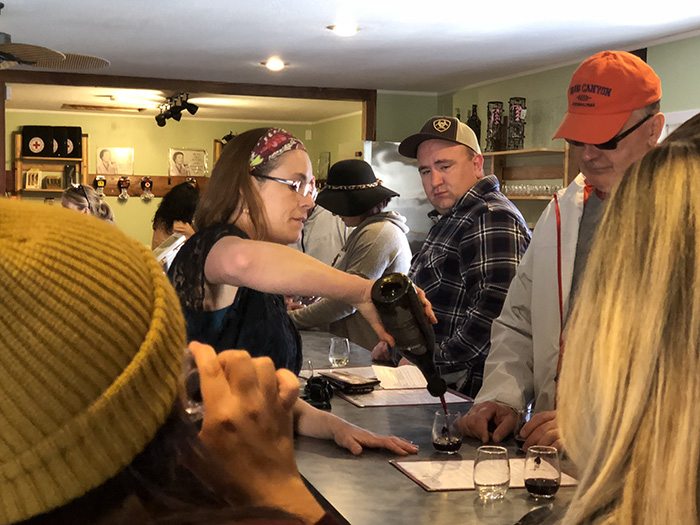When Katie Reeves was in high school, Page Springs Road in Cornville, Arizona was simply just a shortcut that she and her friends often used on the drive to the movies on weekends. Now, Reeves works on the same road her mother cautioned her to avoid, as a tasting room server at Oak Creek Vineyards & Winery.
“Up until the early 2000s when I graduated, you didn’t take this road unless you wanted to risk getting hit by a cow. This was just a poorly paved country backroad my mom would tell me not to use because accidents would always happen.” Reeves said about Page Springs Road.
When she got her job at Oak Cree Vineyards & Winery, she was shocked that the same road now has three busy vineyards with frequent guests for wine tastings.
Arizona’s wine industry is flexing more muscle. According to a study by the Arizona Office of Tourism, the annual economic impact of wine tourism has reached $56.2 million in 2017, up nearly $20 million since the last study in 2011.
“Every state in America makes wine. Arizona has an advantage because we pair wine with our indelible Southwestern landscapes,” said Scott Dunn, senior director of communications and at the Arizona Office of Tourism. “All of our wineries neighbor scenic byways, rivers, state parks or national monuments.”
Arizona’s wine regions are mainly located in Willcox, Sonoita and the Verde Valley, which are near the state’s most popular tourist attractions and vacation destinations. In-state tourists from the Phoenix and Tucson markets are supplying 57 percent of the industry’s visitors, but 43 percent of wine tourists are coming from out of state, according to the tourism office.
Lauren Rankin, tour guide and winery representative at Page Springs Cellars, said that most visitors come from Phoenix, but more and more people have been visiting from out of state.
“The business we get goes hand in hand with Sedona visitors.” Rankin said. “The weekends are so crazy because visitors stop by to enjoy our wine on their way to Sedona. It’s like, no matter where people are from, they’re just so surprised we have a vineyard here and everyone always ask how the heck do you grow the grapes for wine in Arizona?”
Legislation has made it legal for the wine industry in Arizona to experience significant growth in the past decade. Following the U.S. Supreme Court case of Granholm vs. Heald in 2005 that wiped away many restrictive shipping and other business regulations of wineries, Arizona passed SB1276 in 2006 to give the state’s wineries less legal restrictions in selling and producing their wine.

“Arizona wouldn’t even have a wine industry today if it wasn’t for the change in laws.” Said Brian Predmore, president of the Arizona Wine Growers Association. “Legislation changes in 2005 and 2006 made it easier for people to hold a wine license so that’s why there is a boom. Before that, we had no vineyards in this state because the regulations made it impossible to make any money and now we have 106 series 13 licensed vineyards.”
Arizona Department of Liquor Licenses and Control’s In-State Domestic Farm Wineries license, commonly known as the Series 13 license, outlines the business privileges wineries have based largely on the quantity of wine produced. As the law stands now, each winery is allowed to sell no more than 40,000 gallons of wine per year, in or out of state.
Robert Carlson III, co-owner of Carlson Creek Vineyard, said the legislation change in 2006 allowed Arizona wineries to kick start their business, but the law does not allow the volume that is needed to sustain a growing business.
“We started this business nine years ago with only 40 acres of vineyards and now we’ve grown to 280 acres, we’ve opened a second tasting room in Scottsdale, and in the process of expanding even more on our Willcox vineyard.” Carlson said. “We’re not the only vineyard that is and will experience this growth so the 40,000 gallon cap limit needs to be removed. It’s sometimes challenging to get legislators to see that we’re a legitimate growing industry that can give back to rural places in this state.”
According to the Arizona Office of Tourism, the Arizona wine tourism industry has created an estimated 640 full-time jobs and approximately four million dollars in local and state taxes in 2017.
“Fine tuning laws to make sure non-wholesale wine makers have cost effective ways to sell their wines to not only tourists from Arizona but out of state tourists as well is what will make the growth substantial enough to compete with other states.” Predmore said. “It cost so much money to ship to our out of state customers and it’s unfair that because of those laws, we’re unable to be in the top 20 states in this industry.”
Annie Skinner, wine judge and author of the food and drink blog Sippy Bites, said the main thing the Arizona wine industry need to focus on right now is strengthening its marketing campaigns.
“I’ve lived in Arizona for years and if I wasn’t in the wine judging business I wouldn’t even know there are these established wineries people can go visit.” Skinner said. “Since Arizona is new to the industry, the quality of the wines can’t compare to that of states like California or Washington, but they’re not going to ever get there if no one knows about them. Above all else, the wineries need to come together to figure out a way to get the word out better so they can maybe compete with other new players on the U.S. wine stage, like Texas.”





